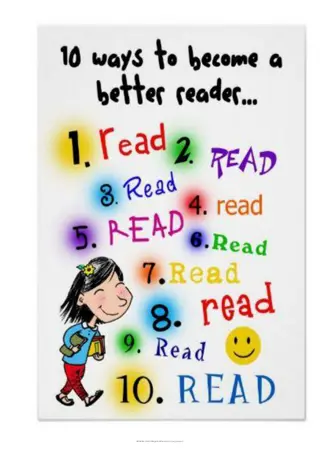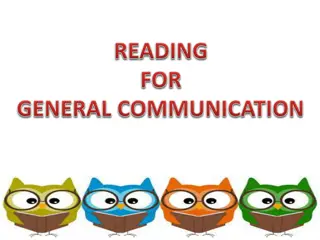Effective College Reading and Analysis Strategies for Non-Fiction Texts
Enhance your non-fiction reading and analysis skills with these practical tips: prepare yourself mentally before reading, preview the article, highlight key points while reading, monitor comprehension, and summarize the article afterward. Additionally, learn how to create a rhetorical précis to effectively analyze non-fiction texts.
Download Presentation

Please find below an Image/Link to download the presentation.
The content on the website is provided AS IS for your information and personal use only. It may not be sold, licensed, or shared on other websites without obtaining consent from the author. Download presentation by click this link. If you encounter any issues during the download, it is possible that the publisher has removed the file from their server.
E N D
Presentation Transcript
Rhetorical Reader Response Tips on Reading and Analyzing Non-Fiction Mrs. Opaleski-DiMeo
College Reading Tips Before you read Know yourself. Are you mentally prepared to focus or do you need to eat, eliminate distractions, exercise etc? Also know how long you can concentrate. Know why you are reading. Know why the article was assigned and how it fits into the context of the course. Preview the article. Who is the author and what are their credentials? When was it written? Who published it? What do you predict the article will be about? What do you already know about the topic? Skim the article. Read the section headings. Look at the pictures or diagrams. Read the intro and conclusion.
College Reading Tips As you read Highlight, mark, take notes . . . whatever system works for you to keep your mind focused. I usually highlight one main point per paragraph and write a key word next to it to remind me what the paragraph is about. Talk back to the article. Use exclamation points, question marks, bullets or any system you prefer to record your reactions. Monitor your comprehension. As you read, periodically pause and check if you are understanding. Can you summarize what you just read? Can you mentally picture what is happening? Could you diagram the argument? Dealing with new vocabulary. If you have much new vocabulary, you should probably look them up before you start reading. But if it is just a few words, I suggest getting the basic meaning from context, marking the word, and looking it up afterwards. If you try to look up every word as you come to it, you will break the flow of your reading and lose comprehension.
College Reading Tips After you read Summarize the article. You can do this in paragraph form, an outline, a chart, cartoon or physical model. Use a system that works best for you. Prepare questions and comments for class discussion. Certainly ask about parts that confused you. But also ask questions that will help us think about the article more deeply. How could we connect it to topics we've been discussing? How is it working as a piece of writing?
The Rhetorical Precis Recap Write a rhetorical pr cis in your own words (with no words borrowed directly from the text) using the following format: Sentence 1: Name the author, title of the work, and the author s credentials (ethos); a rhetorically active verb (such as claims, argues, asserts, defines, explores or suggests see handout on Active Verbs); and a that clause containing the major assertion, main idea or thesis in the work. Sentence 2: An explanation of how the author develops and supports the thesis (i.e. evidence) usually in chronological order. Sentence 3: A statement of the author s apparent purpose, followed by an in order to phrase. Sentence 4: A description of the intended audience and/or their relationship the author establishes with the audience. Here is where you also discuss the tone of the article.
Sentence #1 The thesis, or major claim, of the work is statement of the overall and final point that it aims at. It is not easy to identify the thesis of a philosophical work (or novel, for that matter). Still, it is a basic part of philosophical reading to be able to say briefly what the main claim of the work is. Note that this claim may never be stated by the author as such. You may have to interpret and synthesize to draw out a thesis. This work is essential because it is the base of your reading. The thesis statement you attribute to a work is your concise summary of what you understood the author's point to be. You may find it frustrating to put the meaning of a long, complex work into a single sentence. If you simply draw a blank or cannot get the words to come out right, that is a sign that you need to read the work again with the intention of getting the major claim.
Sentence #2 Explanation The task of this sentence is to explain how the thesis, presented in the last sentence, is developed by the author. The author may give several arguments for a single thesis. Or the author may give a chain of arguments leading up to the thesis. The author may define key concepts related to the thesis. Your job in reading intellectual literature is to identify how the main claim is produced by the work. We take it as a basic standard here that sophisticated literature does not merely make claims, it provides support for them.
Sentence #3 Purpose A statement of the author's purpose in writing this work. What is the writer trying to accomplish here? This statement of purpose is connected to the audience effect by the in order to phrase.
Sentence #3 In Order To This phrase is crucial to the Pr cis. It directly indicates the effect the author intends to have upon the audience. To produce this sentence, think about what change will occur in the reader if the author's purpose is successful. Authors may write with the purpose to persuade, to refute, to change, even to frighten, anger, or confuse. Determine what you think the author's purpose is and what that purpose is supposed to do to the reader. Note that the purpose may or may not be successful (i.e. it may not have the intended effect).
Sentence #3 ) Effect A statement of the author's intended effect on the reader. This statement of purpose is connected to the audience effect by the in order to phrase. Every author writes to have some effect on the audience (readers). It may be to make the audience laugh, to cause the audience to question their own beliefs, to persuade them to a point of view, to challenge a belief they are likely to have, etc. This effect is not a report of how the work affects you, but of what you think the author's intended effect is.
Sentence # 4 Audience A statement of the author's intended audience and the relationship the author establishes with the audience. The language of a work selects a certain audience and excludes others. Examine the language and references of the work to judge what sort of pre-knowledge the author assumes of the reader and how that affects tone.
Precis Example #1 Charles S. Pierce's article, "The Fixation of Belief (1877), asserts that (1) humans have psychological and social mechanisms designed to protect and cement (or "fix") our beliefs (2). Pierce substaniates this claim with descriptions of four methods of fixing belief, pointing out the effectiveness and potential weaknesses of each method (3). Pierce's purpose is to demonstrate the ways that people commonly establish their belief systems (4) in order to (5) jolt the awareness of the reader into considering how their own belief system may the product of such methods and to consider what Pierce calls "the method of science" as a progressive alternative to the other three (6). Given the technical language and the academic tone used in the article, Pierce is writing to an well-educated audience with some knowledge of philosophy and history and a willingness to other ways of thinking (7).
Precis Example #2 Sheridan Baker, in his essay "Attitudes" (1966), contends that writers' attitudes toward their subjects, their audiences, and themselves determine to a large extent the quality of their prose. Baker maintains this assertion by showing examples of how inappropriate attitudes can make writing unclear, pompous, or boring, concluding that a good writer "will be respectful toward his audience, considerate toward his readers, and somehow amiable toward human failings" (58). His purpose is to make his readers aware of the dangers of negative attitudes in order to help them become better writers. Using an encouraging, colloquial tone, Baker establishes an informal relationship with his audience of college students who are interested in learning to write "with conviction" (55). From (English 8601 Dr. William P. Banks)
Tips on Writing a Strong Precis Ethos Who is the author his/her credentials and/or experiences? Is the person a doctor, a student, an expert ?Why is he/she writing this? READ THE ITALICS! Rhetorically active verbs Avoid says or states ; BE PRECISE! USE THE LIST I GAVE YOU!
Tips on Writing a Strong Precis Author s Purpose Express and Reflect the writer expresses or reflects on his or her own life and experiences; often looks backward to look forward Inform and Explain the writer states a main point and purpose; tries to present the information in a surprising way Evaluate and Judge focuses on the worth of a person, object, idea, or other phenomenon; usually specifies the criteria to the object being seen as good or bad
Tips on Writing a Strong Precis Author s purpose (continued) Inquire and Explore the writer wrestles with a question or a problem; hooks with the problem and lets the reader watch them wrestle with it Analyze and Interpret the writer seeks to analyze and interpret phenomena that are difficult to understand or explain Take a stand/Propose a Solution the writer seeks to persuade audiences to accept a particular position; describes the problem, proposes a solution, and provides a justification
Tips on Writing a Strong Precis Audience Analysis Who would be interested in this topic? Men, women, students, scholars? Where did the article originally appear? Who reads this magazine or journal? What type of vocabulary is used? Technical, formal, elevated, informal, colloquial? What year was this article published? What was going on in the world then?
Tips on Writing a Strong Precis How to Identify Tone Look at the adjectives . Are they positive, negative, in some sort of pattern? Look at the syntax and punctuation. Are there italics, bold, or use of parenthesis? Are there dashes, semicolons, exclamation points?
Tips on How To Respond I agree with So-and-so s idea/contention/view that _____. Tell WHAT you agree with and WHY. Develop your ideas thoroughly. If there are various points you agree with, take each one in turn and discuss what you agree with why. I agree with So-and-so s point/ idea/contention about ______, but disagree with _____. Tell what you agree with and why and what you disagree with and why. Develop your ideas thoroughly. If there are various points you agree and disagree with, take each one in turn and discuss what you agree with and why and what you disagree with and why. Be careful here make sure that your point is clear; make sure you take a real stand. If you disagree more than you agree, deal with the agreement first, then the disagreement. Leave your reader clear about your position. BE SPECIFIC AND QUOTE THE AUTHOR!























